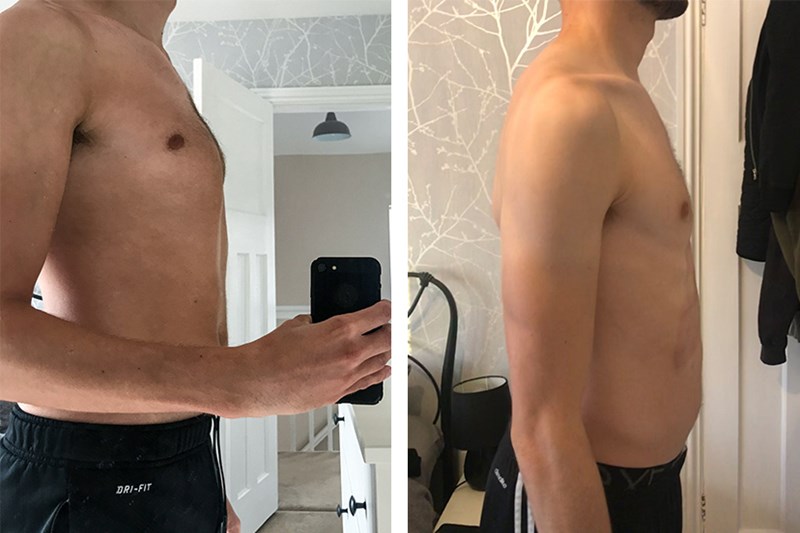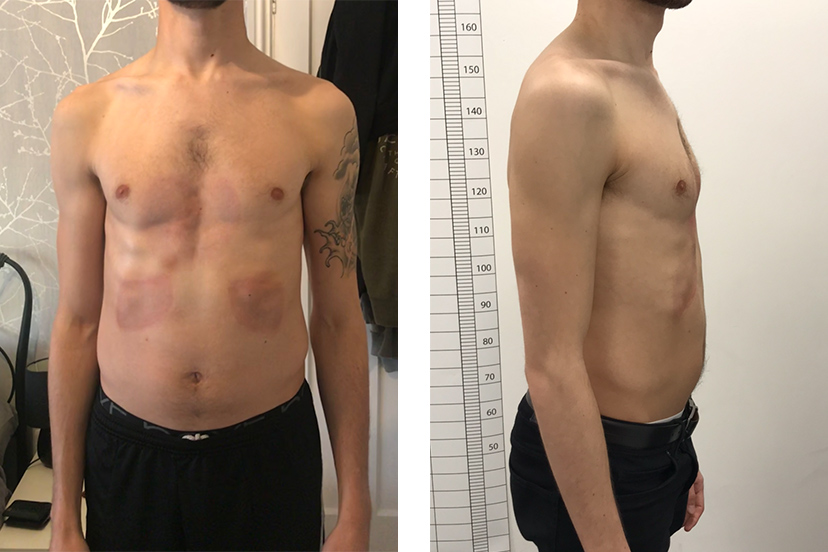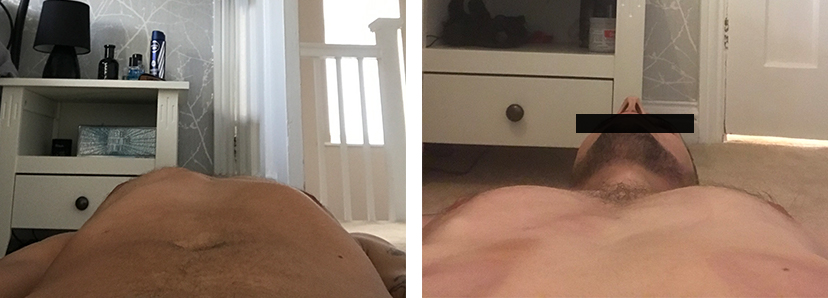
Above: Before (left) and during treatment (right)
10 October 2018
Like many adults with pectus carinatum, 24-year-old Jamie thought he’d missed the boat when it came to correct his condition.
Pectus carinatum affects around one in 1,500 people, also known as 'pigeon chest', is a congenital deformity of the anterior chest wall, which occurs when the breast bone (or sternum) is pushed outward by an abnormal overgrowth of cartilage, causing visible protrusion of the bone and, in some cases, other related symptoms, such as respiratory problems. It is present at birth but often becomes more noticeable in early adolescence when the ribcage and the rest of the body undergo growth spurts.
Indeed, Jamie was around 12 or 13 when he first noticed something different about his chest and, while it bothered him, he didn’t think there was anything he could do. Eventually, he consulted his GP and was told about the option of surgery on the NHS, but was soon put off by the risk of scarring, lengthy recovery time (impractical for someone like Jamie with a full-time job in marketing) and possible failure to correct the problem.

Above: Photos taken during treatment
It was while on a beach holiday - and feeling particularly self-conscious about revealing his deformity when topless - that he was finally spurred on to seek other options. However, frustrated by a lack of information about treatments for adults, Jamie feared that because his bones were no longer growing and the reduced elasticity in his chest (which is more malleable in adolescents) would mean his condition could no longer be corrected. In desperation, he turned to Google and that’s where he found the London Orthotic and immediately contacted us.
Jamie has now been a patient at the LOC for the past six months, with roughly another six to go until his treatment is completed, and he’s making excellent progress. Following his initial consultation with one of our clinicians, Sam Walmsley, he began our non-surgical treatment for pectus carinatum, which involves wearing a bespoke brace – the Dynamic Chest Compressor - combined with a programme of daily exercises. The brace applies constant pressure over the area of the chest that needs to be remodelled. Because pectus carinatum is caused by the chest protruding, we use a brace that fits over the apex of the chest to push it in – the dynamic chest compressor 1 – for the upper chest. In cases where the ribs protrude as well, the lower dynamic chest compressor 2 may be needed. As the upper chest is forced inward, the lower ribs tend to flare out so we use this lower brace to push the ribs back in.

Above: LOC's Dynamic Chest Compressor
Initially, Jamie found the brace a challenge. “Because I’m an adult and my bones are more rigid, it was really painful for the first three or four months,” he says, “but once I got past that period of correction, it wasn’t too bad, and now it doesn’t really hurt at all.”
Although he was a bit self-conscious about wearing the brace, Jamie says his friends and work colleagues, while inquisitive at first, have been very supportive, which has helped him to remain committed to his programme. And, now that he has been wearing the brace for six months, there is a little more flexibility. “You can get to a point, like where I am with Sam, where he says: ‘If you need the brace off for a few hours every now and again, you can,’” says Jamie. “I play football, so I can take it off for training and when I play on Saturdays.”
Jamie admits that it hasn’t always been easy: “You keep questioning yourself over and over, ‘Is it going to work for me? Am I ever going to be able to sleep in it? Am I ever going to not find it painful?’ You start thinking all of those things, but eventually, it just clicks, it might take four or five months, but once it does, it’s a lot easier to wear.”
He started seeing results within a couple of months of beginning his treatment, which really spurred him on to stick with it. “And now, six months in, I can see light at the end of the tunnel. It’s just a year, blast through it and you’re done, aren’t you?” he reasons.
As well as wearing the brace, which Jamie has had adjusted four times so far, he has a set of exercises to follow. “These are particularly important in the first two or three months, while you’re stretching your chest into the brace so that you get the correction,” he says. And, fitting them around work hasn’t been too much of a challenge. “I used to mainly do press-ups because you can do them anywhere, as well as the ones where you stretch through the door, and that’s worked for me. I probably do about 20 minutes at a time,” says Jamie.

Above:
All his hard work has certainly paid off as he’s already delighted with the results. “They’re better than I thought, to be honest,” he says. “When I set out to do it, I was hoping that you couldn’t see the pectus carinatum within my clothes, but I think I’ve got it to the stage where you wouldn’t even know without a top as well. So, it’s pretty much spot on.”
And the benefits are more than just physical. “I think everyone’s noticed that I’ve got better posture, so I’ve felt more confident,” Jamie says, urging others to follow his lead: “Don’t worry about the brace being visible under your clothes, don’t worry about people questioning you because you can get past all that. It is going to be painful in the first few months, but if you can stick through that, then you’ll probably get the result you want.”
For patients considering LOC’s non-surgical treatments for pectus carinatum, the initial consultation is FREE with no obligation to proceed. During the consultation, one of LOC's clinicians will examine your chest and general posture.
If the clinician believes that your chest shape will respond using the dynamic remodelling method and that you are willing to commit to the exercise programme, they will take 3D scans of your chest shape. Further appointments will be made for casting and fitting and you will need to attend the clinic for regular reviews.
This depends on several factors; the position of the chest wall deformity, its severity, the flexibility of the chest, the kind of results wanting to be achieved and the age of the person undergoing treatment for pectus excavatum or pectus carinatum.
Early adolescence (roughly between the ages of 12-16 years old) – is an optimum age to start treatment, given that the chest is still maturing, and flexible, permanent correction is more easily achievable. Once bracing treatment is complete and a patient has stopped growing, the deformity will not return. For younger pectus patients, conservative bracing is used to keep a deformity from worsening and can help them to avoid surgery in later life.
For older pectus patients (between the ages of 20 to 30) results can be harder to achieve, as the costal cartilage hardens into the bone as a person matures. Over the years we have successfully treated many adults for both pectus excavatum and pectus carinatum and active adults with flexible chests can expect good results.
Again, this hugely depends on what a patient wants to achieve from treatment; whether that’s avoidance of surgery, improvement in the appearance of the chest shape, reduction in rib flaring etc. All these goals are taken into consideration during your first consultation. While there are no serious health risks of having pectus carinatum or excavatum – beyond the cosmetic – for many patients and parents, treatment outcomes involve improving confidence and self-esteem. During our 2018 Pectus Patient Survey, 92% of pectus carinatum patients surveyed said that treatment had a ‘major improvement’ or ‘an improvement’ on their social life.
You can read the results of our 2018 Pectus Patient Survey and quality of life questionnaire here.
Regular reviews are part of the treatment programme, preferably in clinic with one of our specialist orthotists, or via Skype consultations.
The number of appointments needed will vary from patient to patient but as a general rule, younger pectus patients who are growing at a faster rate will need to be seen more regularly for check-up appointments. This is to ensure that the brace fits well and is guiding the chest into the correct position as growth spurts occur. For other patients, this can be scaled back according to their individual needs and demands.
Regular appointments are beneficial for assessing progress, checking for signs of rubbing and determining whether another brace is needed. Appointments are also good for checking patient compliance to brace wearing and the breathing and exercise programme. At each appointment, we make time for patients to see our physiotherapist to fine-tune their exercise programme and check to see how a patient has been managing with the current programme.
We always advise coming in for appointments whenever you have any concerns about the brace or treatment programme, especially if a brace is rubbing or not fitting correctly. At the London Orthotic Consultancy, we have treated numerous international patients that have benefitted from specially designed braces that leave room to accommodate for growth and that can be adjusted remotely. Follow-up appointments for international patients are conducted via Skype.
This is a very common concern for patients considering treatment; in general, the dynamic chest compressor brace is easy to conceal if you are wearing a loose-fitting shirt for school or work. If you are wearing two chest braces – one for the main deformity and the other for rib flaring – then this may be more noticeable, especially under a t-shirt. Normally loose-fitting clothing will conceal the brace, though it’s likely it will be seen through tight-fitting clothes.
It is really important to continue exercising while going through bracing treatment. Exercise is fundamental to keeping the chest wall flexible. Our treatment programme incorporates a daily exercise routine of around 30-40 minutes of stretching using yoga poses, resistance bands, deep breathing exercises and general muscle stretches. Deep breathing exercises allow the lungs to expand against the chest wall, pushing it outwards.
Exercising with the brace on in the later stages of treatment can also make the chest correction more stable and permanent.
Swimming is one of the best forms of exercise to complement bracing treatment, as the body positions required to swim imitate the resistance band training designed to stretch the chest and increase its flexibility. Some swimming strokes are better for this than others, please check with your clinician. The brace should always be removed for contact sports and for swimming.
For most patients, one brace is often all that is needed to achieve a desired level of correction. They are each designed to last the duration of treatment and accommodate any growth that may occur in that time. Some patients have benefitted from having two braces – one to treat the main deformity and the other to treat rib flaring. For some pectus excavatum patients, having a brace apply pressure to the ribs – in addition to vacuum bell therapy – can greatly reduce the appearance of the depressed sternum area of the chest, forcing it upwards and outwards into a more corrective position.
If you are worried about your chest shape, or your child’s chest shape, then get in touch for a free Skype consultation with one of our pectus specialists who can assess their chest and discuss treatment options. We are always happy to communicate with local GPs, thoracic surgeons and consultants if a patient approaches us for bracing treatment after considering other options.